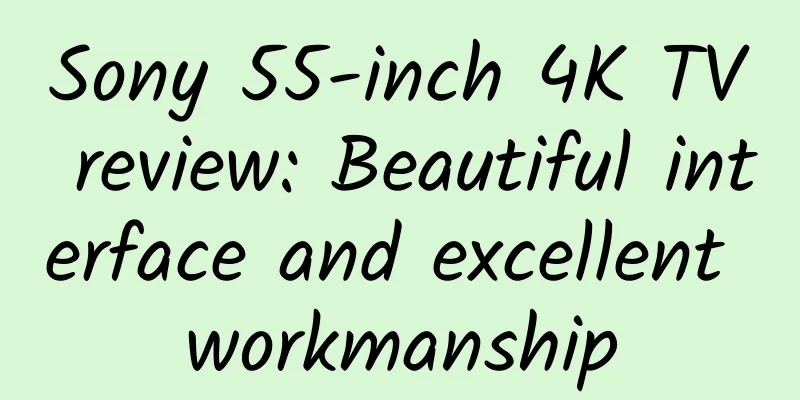The stay-at-home economy opens a new era of TV marketing, and Coocaa Technology leads OTT marketing into the second half

|
As the OTT marketing industry continues to evolve in terms of standardization and normalization, the living room economy is moving out of the "value trough" and winning the recognition of brand owners. As smart TV marketing moves from simple on/off promotion to the content layer and system layer, the value fog that shrouds the large screen in the living room has been lifted, and OTT marketing has officially entered the second half. The booming living room economy opens up a new blue ocean for large-screen marketing As the epidemic recurred, the stay-at-home economy quickly boosted the rise of the living room economy. The "2020 COVID 19 BAROMETER" report released by Aowei Interactive Entertainment and KANTAR showed that users' willingness to watch smart TVs increased significantly after the epidemic compared to before the epidemic. The average daily usage time of smart TVs increased from 4.5 hours to 5.3 hours, and each user watched 49 minutes more on average every day. At the end of April 2022, the State Administration of Radio and Television released the "2021 National Radio and Television Industry Statistical Bulletin". Data showed that as of the end of 2021, the number of Internet TV users nationwide had reached 1.083 billion, and the proportion of OTT in content consumption had increased significantly. The extremely high terminal coverage rate has also made OTT a new favorite in the eyes of content platforms. According to the Aowei Interactive Entertainment data system, as of February 2022, the daily active users of OTT in my country have exceeded 1.16 billion, and continue to show an upward trend. In the on-demand media rankings, Galaxy Kiwi continued to lead the industry in the first quarter, with an average monthly daily active user scale of over 40 million, of which the highest daily active user scale in February was 43.97 million. CIBN Kuai Miao Film and Television and Cloud Video Aurora followed closely behind. At the same time, more and more content platforms are constantly strengthening the large-screen application experience, and OTT platforms have also become an important position for the distribution of new movie content. In addition to traditional long videos on the large screen, short and medium video platforms such as Bilibili, Xigua Video, and Kuaishou have also begun to increase their large-screen layout. At a time when the mobile Internet traffic dividend has been exhausted and turned into the stock market, the large screen in the living room has become a traffic pool that has yet to be developed. iQiyi has disclosed data showing that during the Spring Festival, users watched nearly 200 million hours of movies on iQiyi, of which Internet TV users accounted for nearly 50%; The MAU of the cloud audio-visual small TV terminal is surpassing that of the PC terminal, which is called "beyond expectations" by B station CEO Chen Rui: "Not only the number of users has increased, but the playback time on TV is also longer than other terminals", "The user overlap rate between the TV and mobile terminals is less than 20%. This completely differentiated user base has given B station great confidence." The shift in user attention has brought about a leap in the value of OTT marketing. According to the IAB's "Video Marketing Spending 2021 and Outlook for 2022" report, digital video marketing spending will increase by 49% in 2021 and is expected to increase by another 26% in 2022 to $49.2 billion. Among them, connected TV marketing spending will increase by 57% in 2021 to $15.2 billion, and is expected to increase by another 39% to $21.2 billion by 2022. The OTT living room large screen has become a rare incremental oasis in the marketing industry surrounded by a red ocean, a new blue sea. Industry chaos drags OTT into a value trough OTT marketing has long been in a "value trough" due to the long-term chaotic industry environment of large-screen marketing. Compared with more mature PC and mobile Internet marketing, OTT marketing has problems such as single form, low exposure, high homogeneity, chaotic channels, lack of unified standards for data monitoring, etc., which makes brand owners always have doubts about large-screen marketing. For this reason, the marketing value of OTT, which has been separated from traditional television formats and has taken advantage of the Internet, is far less than the previous television marketing price, and its value has been underestimated by all parties for a long time. In the past few years, many smart TV platforms are still in the short-term operation thinking of using startup marketing as the main selling resource. They rigidly apply the form of smartphone APP startup marketing to OTT platforms, but ignore the fact that smart TVs are started up frequently, which reduces the exposure rate of large-screen marketing. At the same time, marketing that is seriously separated from content has also caused widespread negative feedback from users. Moreover, simply relying on TV penetration and market share for marketing capabilities is extremely detrimental to the development of the industry. Faced with the fact that marketing capabilities are insufficient, many OTT manufacturers choose not to keep pace with the times and expand channels, but to cover up the real traffic at the data monitoring end, which has led to industry chaos such as fake traffic and abnormal traffic, further exacerbating brand owners' doubts about the effectiveness of large-screen marketing. Standardization and regularization of the OTT marketing industry is imperative. It is gratifying that, driven by the stay-at-home economy and the industry pioneers' ardent innovation, with large-screen marketing penetrating into the content and system layers, the chronic problems that hinder the release of value have been removed one by one, and OTT marketing has entered the second half. Here we have to mention the industry’s first unicorn company, Coocaa Technology, which has been continuously innovating to address industry problems since 2018 and has achieved a breakthrough in OTT value. In response to the problem of single startup advertisement format and low exposure rate, Coocaa Technology chose to extend its marketing capabilities to the content and system layers, and launched a variety of promotional forms including screen dominance, channel entrance, recommendation position, patch, screen saver, application entrance, global pop-up window, etc., which not only greatly improved the push effect, but also relied on the precise push of big data user portraits to significantly increase the opening rate of related pages. Relying on its coverage of 128 million terminals (data as of March 31, 2022) and more than 1/3 of the market share, Coocaa Technology has taken the lead in writing a template for standardization and regularization of the OTT industry. Coocaa Technology not only provides brand owners with native DMP data management platform and CDP user data platform, but also integrates with third-party DMP and brand owner's DMP to form a refined data linkage advantage. At the same time, it also abandons S2S monitoring methods and uses SDK-level full-flow C2S monitoring and third-party monitoring to make traffic data accurate and transparent. Combined with full-link decision-making, adjustment and review before, during and after launch, it creates long-term marketing plans for brand owners and achieves "product and effect integration" of increasing sales and enhancing brand value at the same time. Practice is the only criterion for testing truth Recently, Coocaa Technology and other OTT manufacturers have joined hands with GroupM Think Tank and more than a dozen brands in categories such as fast-moving consumer goods, entertainment, and luxury goods. Through marketing science methodology and multi-dimensional user measurement, they have conducted data analysis and effect verification based on real delivery, measured the real effect of OTT delivery, and finally jointly released the "OTT Business White Paper". The "OTT Business White Paper" points out the three major logics of brand OTT delivery, namely buying cognition, buying synergy, and buying consensus. Awareness is the beginning of the consumer chain. The independent reach, high-quality visual effects, and ability to showcase brand quality of large-screen TVs are more prominent than other media, and are more effective in building consumer awareness. In the case of Michael Kors, after the brand launched the splash screen advertisement on the large screen, the awareness increased by 27%. In the exposed group, the awareness of Michael Kors was 47% higher than the average of other competing products; in the case of a certain brand of toothpaste, the brand awareness increased significantly by 54% after the marketing launch, and the awareness among the exposed population was 60% higher than the same category of competing products. On the basis of the increase in awareness, the purchase intention of the brand was further improved. Compared with the non-exposed group, the purchase interest of the exposed brand increased by 101%. Buying consensus means forging a consumer consensus in the living room space by relying on the family attributes of the large-screen TV. Among the many consumer categories, some categories naturally have family consumption attributes, such as maternal and child products, movie entertainment, etc. The decision-making scenarios for such categories are often within the family. In addition, the purchase of categories such as automobiles and home furnishings often also requires family decision-making. Even consumption decisions on some gifts and luxury goods require a common understanding of the products among family members. The marketing of these categories of consumer products can achieve good results through OTT delivery. Similarly, in the case of Michael Kors, the marketing content released on OTT was not only strongly related to the movie, but also built an exclusive "MKCx007 Super Theater" to achieve secondary brand exposure. The survey results show that consumers who have seen OTT marketing are significantly more willing to buy MK than those who have not seen the marketing, and the purchase intention increase rate is as high as 70%. According to Shanhaijin data, 28.2% of consumers will use search engines such as Baidu to search for information related to the program content while watching on the big screen, 34.4% of consumers will use social media such as WeChat and Zhihu to search for information related to the program they are watching, and 30.9% of consumers will search for products that arouse their interest in the program on e-commerce platforms. Buying synergy means paying full attention to consumers' habit of using small screens while watching large screens, and using the strong interaction between large and small screens to enhance the synergy effect of social and e-commerce media. In a case of a snack marketing campaign that was simultaneously launched on both large and small screens, consumers' awareness of the brand increased to 95.5%. Compared with the simple small screen campaign, the purchase intention of consumers who were exposed to both large and small screens increased by 35%, proving that the synergy of large and small screens can indeed help brands increase awareness and purchase intention. In summary, under the leadership of industry leaders such as Coocaa Technology, the OTT industry has broken away from traditional TV marketing thinking, and through scientific methodology and comprehensive user measurement, it has dispelled the fog of large-screen marketing. Under the guidance of case analysis and data verification, it has gradually shaped a standardized and normalized OTT marketing chain, officially opening the second half of the OTT commercial marketing battle. As a winner of Toutiao's Qingyun Plan and Baijiahao's Bai+ Plan, the 2019 Baidu Digital Author of the Year, the Baijiahao's Most Popular Author in the Technology Field, the 2019 Sogou Technology and Culture Author, and the 2021 Baijiahao Quarterly Influential Creator, he has won many awards, including the 2013 Sohu Best Industry Media Person, the 2015 China New Media Entrepreneurship Competition Beijing Third Place, the 2015 Guangmang Experience Award, the 2015 China New Media Entrepreneurship Competition Finals Third Place, and the 2018 Baidu Dynamic Annual Powerful Celebrity. |
<<: Will artificial intelligence really destroy humanity?
>>: 11 Tragedy of Working at Google: Too Much Stress to Enjoy Life
Recommend
Messaging apps will become the next generation of Internet portals
[[126960]] The New York Times wrote that the func...
Samsung Galaxy Fold review: An imperfect folding screen, a promising new form factor
Ten years ago, the interaction method of smartpho...
The critical flood prevention period from the end of July to the beginning of August is approaching. How can we safely prevent risks?
China has fully entered the main flood season and...
Good operations must have strong persuasiveness. Here are three tips for you.
Whether in our daily life or work, dealing with p...
Apple can’t escape the law of true fragrance: iOS 16 will be embedded with a large number of advertisements, will you buy it?
I once saw someone say in a forum: The only reaso...
Yan Su's personal profile: The number of website contents collected does not directly affect the keyword ranking
Is there a direct correlation between a site'...
Korean automakers offer huge subsidies in the U.S. to maintain sales, but remain indifferent to the decline in the Chinese market
Korean automakers really need to think carefully ...
Ford is helpless as GM executives are selected into Trump's think tank
According to foreign media reports, General Motor...
Case review + fission methodology | Why is your fission activity ineffective?
I recently chatted with a fellow operations partn...
Why do men with impotence often fart? Clinical research gives the authoritative answer!
Recently, the COVID-19 epidemic has reached a cli...
Two-year study reveals big problems for Android
[[268883]] A study conducted over a two-year peri...
Practical! Keep this guide to avoid scams during the May Day holiday
Have you ever encountered the traps of holiday tr...
4 elements to help you understand a product membership system
If a product wants to continuously obtain user va...
Don’t know how to write a Mother’s Day copy? Share 9 classic cases of brands leveraging momentum!
Mother's Day is a holiday to thank mothers. N...
Honda China: From January to December 2024, Honda China's cumulative terminal vehicle sales were 852,269 units, a year-on-year decrease of 30.9%
Honda China announced its performance for the pas...









